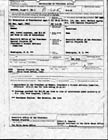Lloyd
Viel Berkner (February 1, 1905, in Milwaukee, Wisconsin
– June 4, 1967, in Washington, D.C.) was an American
physicist and engineer. He was one of the inventors of
the measuring device that since has become standard at
ionospheric stations because it measures the height and
electron density of the ionosphere. The data obtained
in the worldwide net of such instruments were important
for the developing theory of short wave radio propagation
to which Berkner himself gave important contributions.
Later
he investigated the development of the Earth's atmosphere.
Since he needed data from the whole world, he proposed
the International Geophysical Year in 1950. At that time,
the IGY was the largest cooperative study of the Earth
ever undertaken.
Berkner
was elected a Fellow of the American Academy of Arts and
Sciences in 1956.[4] The IGY was carried out by the International
Council of Scientific Unions while he was president in
1957-59. He was also a member of the President's Scientific
Advisory Committee in 1958 while he was president of Associated
Universities Inc.
In
1963, Berkner, with L.C. Marshall, advanced a theory to
describe the way in which the atmospheres of the solar
system's inner planets had evolved.
Beginning
in 1926, as a naval officer, Berkner assisted in the development
of radar and navigation systems, naval aircraft electronics
engineering, and studies that led to the construction
of the Distant Early Warning system, a chain of radar
stations designed to give the United States advance warning
in the event of a missile attack across the North Pole.
Berkner
worked with Dallas community leaders to establish the
Graduate Research Center of the Southwest (later renamed
the Southwest Center for Advanced Studies, which would
eventually become The University of Texas at Dallas).
He
wrote more than 100 papers and several books, including
Rockets and Satellites (1958), Science in Space (1961),
and The Scientific Age (1964).
In
1961, Berkner was president of the Institute of Radio
Engineers.
Legacy
Lloyd
V. Berkner High School in Richardson, Texas was named
for him in 1969. The lunar crater Berkner was named in
his honor. An island in Antarctica was also named for
Dr. Berkner (Berkner Island) for his work as a radio operator
on the first Byrd expedition to Antarctica in 1927. He
was married to Lillian Fulks Berkner and had two children.
Dr.
Lloyd V. Berkner was an alleged member of MJ-12. Berkner
was executive secretary of the Joint Research and Development
Board under Dr. Vannevar Bush. He also chaired the committee
whose study led to the establishment of the Weapons Systems
Evaluation Group. Berkner subsequently served on the "Robertson
Panel", a civilian scientific advisory panel requested
by the Eisenhower White House, chaired by Cal Tech mathematician
Dr. H. P. Robertson and convened and funded by the CIA.
In 1950 and later, he was a member of a UFO group that
was also funded by the CIA.
From
the National Personnel Records Center in St. Louis comes
a copy Lloyd Berkner's Notice of Personnel Action dated
2-11-59. Clearly stated is the "Executive Office
of the President Special Projects (M) Washington D.C."
also "Appointment by the President as a Member, President's
Science Advisory Committee," effective 12-1-57, was
for the term ending 12-31-58. Given the history of other
Majestic and MJ-12 documents, Berkner was clearly involved
in something special with the Executive Office. The "M,"
possibly for MAJIC just adds to the circumstantial evidence.

Dr.
Lloyd V. Berkner Special Studies Personnel Form
Sources:
http://en.wikipedia.org/wiki/Lloyd_Berkner
http://majesticdocuments.com/personnel/berkner.php
